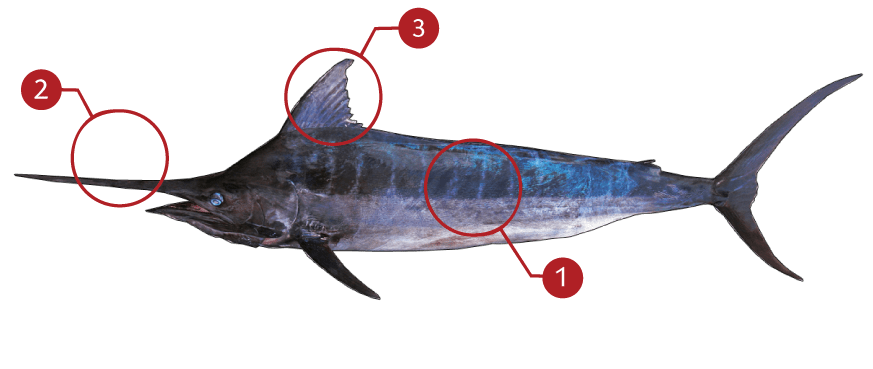BLUE MARLIN
How to identify a Blue Marlin
All giant marlins are females, and male blue marlin are never completely rigid, even after death, and can be folded completely flat against the sides except in the largest specimens. The dorsal fin is high and pointed anteriorly (rather than rounded) and its greatest height is less than the greatest body depth. The anal fin is relatively large and it too is pointed. Juveniles may not share all the characteristics listed above, but the peculiar lateral line system is usually visible in small specimens. In adults it is rarely visible unless the scales or skin are removed. The vent is just in front of the anal fin, as it is in all billfish except the spearfish. The back is cobalt blue and the flanks and belly are silvery white. There may be light blue or lavender vertical stripes on the sides, but these usually fade away soon after death, and they are never as obvious as those of the striped marlin. There are no spots on the fins.
Where to catch Blue Marlin
This pelagic and migratory species occurs in tropical and warm temperate oceanic waters. In the Atlantic Ocean it is found from 45 degrees North to 35 degrees South, and in the Pacific Ocean from 48 degrees North to 48 degrees South. It is less abundant in the eastern portions of both oceans. In the Indian Ocean it occurs around Ceylon, Mauritius, and off the east coast of Africa. In the northern Gulf of Mexico its movements seem to be associated with the so called Loop Current, an extension of the Caribbean Current. Seasonal concentrations occur in the southwest Atlantic (5 degrees to 30 degrees South) from January to April; in the northwest Atlantic (10 degrees to 35 degrees North) from June to October; in the western and central North Pacific (10 degrees North to 10 degree South) in April and November; and in the Indian Ocean (0 degrees to 13 degrees South) from April to October.
IDENTIFICATION

| |
The bill is long and stout and both the jaws and the palatines (the roof of the mouth) are covered with small, file-like teeth |
| |
The back is cobalt blue and the flanks and belly are silvery white and may exhibit light blue or lavender vertical stripes on the sides |
| |
A dorsal fin is high and pointed anteriorly |
TARGET AREAS
|
|
Acknowledgements: We thank TAKEMEFISHING.org (www.takemefishing.org), Wisconsin Department of Natural Resources, Indiana Department of Natural Resources for their contributions to these FISH FACTS.

